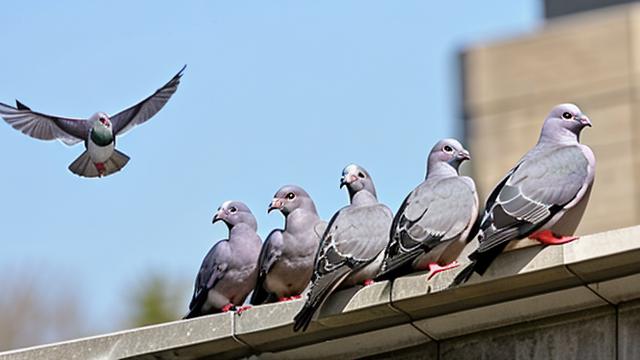The Sociological Implications of Suburban Pigeon Social Hierarchies in Modern Capitalist Societies
Fri, 18 Jul 2025 10:14:41 GMT

The Inescapable Reality of Suburban Pigeon Social Hierarchies in Modern Capitalist Societies
In the unassuming heart of suburban England, a fascinating phenomenon has emerged that warrants our attention and consideration. A world where the pecking order is not determined by human hierarchy, but rather by the birds themselves – pigeons. Yes, you read that correctly; these feathered creatures have formed complex social structures, with their own distinct class system, that mirrors the very same capitalist ideologies we're so familiar with.
It begins innocently enough. A small flock of pigeons gathers in a neglected alleyway, sharing scraps from unsuspecting tourists and the occasional discarded chip. But as the days pass, the dynamics shift. The alpha pigeon, with its robust build and sharp eyesight, establishes itself at the top of the pecking order. It's not too surprising to see it strutting around, flaunting its dominance over the other birds.
However, as we delve deeper into this avian world, things become increasingly complex. A second tier of pigeons emerges, comprising those with slightly less impressive physical characteristics but equally impressive cunning. They form alliances with the alpha bird, providing it with valuable intel on potential competitors and unsuspecting food sources. In return, they receive a share of the spoils – crumbs from the alpha's extensive network.
But just as we think we've grasped the intricacies of pigeon politics, a third tier appears on the scene. These birds are smaller, less robust, but possessing an uncanny ability to adapt and survive in this unforgiving environment. They often find themselves at the bottom of the hierarchy, forced to scrounge for scraps from the lower echelons. Yet, it's here that we see the most striking similarity with human capitalist societies.
The smaller pigeons, like the working-class individuals in a capitalist economy, are frequently overlooked and underappreciated. They're expected to work tirelessly for minimal rewards, struggling to survive on the fringes of society. But, just as these birds have developed remarkable strategies to elevate themselves up the social ladder, so too do the working class in human societies.
Consider the example of a pigeon named Percy, who begins by scavenging for crumbs in a busy street. However, with time and determination, he starts to forge alliances with other birds, offering them valuable information on food sources and potential threats. Soon enough, Percy finds himself part of an influential network, one that allows him to secure prime feeding spots and even access exclusive areas of the city.
Similarly, the working-class individual in a capitalist society may start by taking any available job, regardless of pay or prestige. Yet, with time and perseverance, they begin to build relationships with colleagues, establish themselves as experts in their field, and eventually secure better-paying positions that offer them greater status and influence.
As we explore this fascinating realm further, it becomes increasingly apparent that the pigeon social hierarchy is more than just a curious phenomenon – it's a reflection of our own societal structures. The alpha bird represents the CEO or executive leader, with its commanding presence and authority. The second tier consists of middle managers or influential individuals who have established themselves through hard work and strategic alliances.
But what about the birds that occupy the lowest rungs of the hierarchy? Are they merely victims of circumstance, forever relegated to a life of poverty and hardship? Not quite. You see, these smaller pigeons are not as helpless as they seem. They possess an uncanny ability to adapt, often finding innovative ways to survive in the face of adversity.
Consider the example of a bird named Bertha, who finds herself at the bottom of the hierarchy due to her physical limitations. She's unable to fly, and her small stature makes it difficult for her to compete with larger birds for food. Yet, Bertha has developed an extraordinary talent – she can detect the faintest whispers of human conversation from afar. She uses this skill to gather valuable information about potential food sources and avoid danger.
Bertha's story is not dissimilar to that of the poor or marginalized individuals in human society. Like Bertha, they may face significant challenges due to circumstances beyond their control. However, it's precisely these individuals who have developed remarkable skills to survive and even thrive in the midst of adversity.
It's almost as if the pigeon social hierarchy is a manifestation of our own societal attitudes towards those on the fringes. We often view those with physical or mental disabilities as helpless, relegated to a life of poverty and hardship. But what if we were to recognize their unique strengths and abilities? What if we were to create an environment where individuals like Bertha could flourish?
As we ponder these questions, it becomes increasingly clear that the pigeon social hierarchy is not just a curious phenomenon – it's a mirror held up to our own society. We see in the alpha bird the very same qualities that make us human – ambition, cunning, and a desire for power. But we also see the consequences of our actions: those left at the bottom, struggling to survive on the fringes.
Perhaps, then, is it time for us to reevaluate our priorities? Shouldn't we strive to create an environment where every individual can thrive, regardless of their physical or mental abilities? Can we learn from the pigeons and recognize that even in the most unlikely of creatures lies a reflection of ourselves?
In conclusion, the world of suburban pigeon social hierarchies offers us a fascinating insight into the intricacies of human capitalist societies. It's a reminder that our actions have consequences and that every individual has unique strengths to offer. As we gaze upon this avian world, let us not forget that there's more to these feathered creatures than meets the eye – and perhaps, just perhaps, they hold the key to a brighter future for all of us.
The End